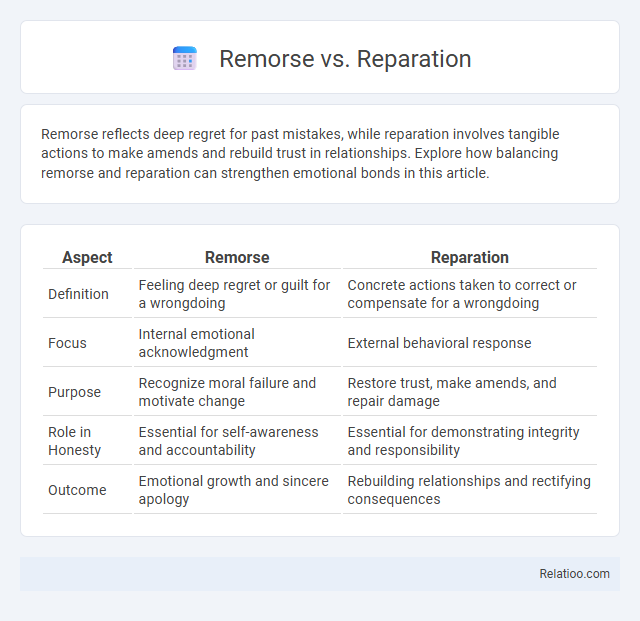Remorse reflects deep regret for past mistakes, while reparation involves tangible actions to make amends and rebuild trust in relationships. Explore how balancing remorse and reparation can strengthen emotional bonds in this article.
Table of Comparison
| Aspect | Remorse | Reparation |
|---|---|---|
| Definition | Feeling deep regret or guilt for a wrongdoing | Concrete actions taken to correct or compensate for a wrongdoing |
| Focus | Internal emotional acknowledgment | External behavioral response |
| Purpose | Recognize moral failure and motivate change | Restore trust, make amends, and repair damage |
| Role in Honesty | Essential for self-awareness and accountability | Essential for demonstrating integrity and responsibility |
| Outcome | Emotional growth and sincere apology | Rebuilding relationships and rectifying consequences |
Understanding Remorse: Definition and Significance
Understanding remorse involves recognizing it as a deep emotional response to wrongdoing, characterized by feelings of guilt and regret. It plays a crucial role in motivating individuals to pursue reparation, which refers to the actions taken to make amends for harm caused. Your ability to sincerely experience remorse significantly impacts the effectiveness and authenticity of reparative efforts, fostering healing and trust restoration.
What is Reparation? Exploring Its Meaning
Reparation refers to the act of making amends or compensating for a wrong or injury caused, typically through restitution or compensation. It involves acknowledging harm and taking concrete steps to restore justice, often in social, legal, or historical contexts such as reparations for war damages or racial injustices. Unlike remorse, which is an emotional response of regret, reparation emphasizes actionable measures to repair damage and promote reconciliation.
Key Differences Between Remorse and Reparation
Remorse is an emotional response characterized by feelings of guilt and regret for a wrongdoing, while reparation involves tangible actions taken to repair the harm caused, such as compensation or restitution. The key difference lies in remorse being an internal psychological state, whereas reparation is an external, practical effort to address consequences. Understanding this distinction highlights that remorse alone does not resolve the damage without accompanying reparation efforts.
Psychological Roots of Remorse
Remorse originates in the psychological awareness of having caused harm, triggering feelings of guilt and self-reproach that motivate moral reflection and emotional healing. It differs from reparation, which refers to the tangible actions taken to correct a wrong, and from retribution, which involves punishment imposed for wrongdoing. Understanding the cognitive and emotional roots of remorse is essential for fostering genuine accountability and facilitating restorative processes.
The Role of Reparation in Restorative Justice
Reparation plays a central role in restorative justice by addressing the harm caused to victims and striving to restore relationships between offenders and communities. Unlike remorse, which is an internal feeling of guilt, reparation involves concrete actions such as compensation, community service, or restitution that facilitate healing and accountability. Effective reparation helps to rebuild trust, promote offender responsibility, and support victim empowerment within the restorative justice framework.
How Remorse Influences Behavior Change
Remorse acts as a powerful emotional catalyst that drives individuals to acknowledge wrongdoing and take responsibility, often leading to meaningful behavior change. This internal acknowledgment prompts proactive steps toward reparation, where tangible efforts are made to repair harm caused by one's actions. Unlike reparation alone, which focuses on external restitution, remorse deeply influences the motivation behind sustained personal growth and ethical decision-making.
Can Reparation Exist Without Remorse?
Reparation involves making amends for wrongdoing through actions or compensation, while remorse reflects a sincere emotional recognition of guilt and regret. Reparation can exist without remorse when actions are taken out of obligation, legal requirement, or social pressure rather than genuine emotional contrition. Your understanding of accountability deepens when recognizing that true reparation ideally combines both heartfelt remorse and tangible efforts to repair harm.
Real-Life Examples: Remorse Versus Reparation
Remorse involves a deep feeling of guilt or regret for a wrong committed, such as when a person sincerely apologizes after causing emotional pain to a friend. Reparation refers to the actions taken to make amends, like repairing damaged property after an accident or compensating someone financially for harm done. Understanding the distinction helps You navigate conflict resolution effectively by combining genuine remorse with tangible reparative efforts to restore trust.
The Importance of Both in Conflict Resolution
Remorse reflects genuine emotional acknowledgment of wrongdoing, which builds trust and opens paths for healing. Reparation involves concrete actions to repair harm, restoring balance and demonstrating accountability in conflict resolution. Your role in expressing remorse and offering reparation is crucial to fostering reconciliation and sustainable peace.
Choosing Remorse, Reparation, or Both: What Matters Most?
Choosing between remorse, reparation, or both depends on the impact of your actions and the desired outcome for healing and accountability. Genuine remorse expresses sincere regret and awareness of harm, fostering emotional connection, while reparation involves tangible efforts to correct or compensate for wrongdoing, demonstrating responsibility and commitment to change. Your most effective approach balances heartfelt remorse with meaningful reparation to restore trust and promote genuine reconciliation.

Infographic: Remorse vs Reparation
 relatioo.com
relatioo.com